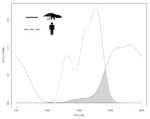Nativas versus exóticas: ¿cuánto contribuyen en la dieta del puma Puma concolor en el Parque Nacional Los Glaciares, Patagonia, Argentina?
Cristina Bartolucci, María de las Mercedes Guerisoli, Gabriel M. MartinEl puma se encuentra actualmente entre los carnívoros más conflictivos de Argentina debido a la depredación de animales domésticos. Su dieta ha sido estudiada en Patagonia, encontrándose un consumo, principalmente, de especies exóticas y nativas. El objetivo de este trabajo fue caracterizar la dieta del puma en el Parque Nacional Los Glaciares (PNLG), provincia de Santa Cruz. Se realizaron recorridas por los principales senderos del PNLG durante los años 2004–2006, donde se colectaron 68 heces de puma. Para determinar los ítem-presa se utilizaron pelos, mandíbulas, maxilares, dientes y plumas encontrados en las heces y se calculó la frecuencia de ocurrencia (FOi) y la biomasa consumida (BC). Se identificaron 19 especies de mamíferos: 14 nativos, cuatro domésticos y uno exótico. Los valores más altos de FOi fueron para la liebre (95.58 %) y el piche (57.37 %), seguido por el caballo (33.82 %). Las especies que más aportaron a la BC fueron la liebre (valores entre 23.68 % y 22.79 %), el caballo (valores entre 21.65 % y 17.97 %) y la oveja (valores entre 16.08 % y 17.12 %). Estos resultados para el PNLG indicarían una tendencia al consumo de especies exóticas y domésticas por sobre las especies nativas. Las especies domésticas serían consumidas por este felino fuera del parque. Futuros estudios deberían orientarse a aumentar el conocimiento sobre la dieta del puma dentro y fuera del PNLG, y a estudiar la disponibilidad de presas nativas para generar información que favorezca la coexistencia entre los productores y los carnívoros.
Native versus exotic: how much do they contribute to the diet of the puma Puma concolor in Los Glaciares National Park, Patagonia, Argentina? The cougar is currently among the most conflictive carnivores in Argentina due to the predation of domestic animals. Their diet has been studied in Patagonia, finding a consumption mainly of exotic and native species. The objective of this work was to characterize the cougar’s diet in Los Glaciares National Park (LGNP), Santa Cruz province. Tours of the main trails of the LGNP were carried out during the years 2004–2006, where 68 cougar feces were collected. To determine the prey items, hairs, mandible, jaws, teeth and feathers found in the feces were used, and the frequency of occurrence (FOi) and the biomass consumed (BC) were calculated. Nineteen mammal species were identified: 14 native, 4 domestic and 1 exotic. The highest FOi values were for the hare (95.58 %) and the piche (57.37 %), followed by the horse (33.82 %). The species that contributed the most to the BC were the hare (values between 23.68 % and 22.79 %), the horse (values between 21.65 % and 17.97 %) and the sheep (values between 16.08 % and 17.12 %). These results for LGNP show a trend towards the consumption of exotic and domestic species over native species. The domestic species would be consumed by this feline outside the park. Future studies should focus on increasing the knowledge of the diet of the puma inside and outside of PNLG and in the study of native prey availability, to generate information to promote coexistence between ranchers and carnivores.

